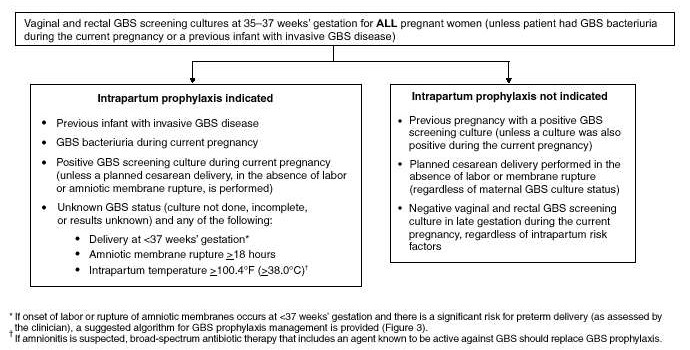Group B streptococcal infection: Difference between revisions
No edit summary |
m (Robot: Automated text replacement (-{{SIB}} + & -{{EH}} + & -{{EJ}} + & -{{Editor Help}} + & -{{Editor Join}} +)) |
||
| Line 43: | Line 43: | ||
[[fr:Streptocoque B]] | [[fr:Streptocoque B]] | ||
[[Category:Streptococcaceae]] | [[Category:Streptococcaceae]] | ||
Revision as of 15:41, 9 August 2012
For patient information click here
Template:DiseaseDisorder infobox
Editor-In-Chief: C. Michael Gibson, M.S., M.D. [1]
Overview
Infection with Group B Streptococcus (GBS), also known as Streptococcus agalactiae, can cause serious illness and sometimes death, especially in newborn infants and the elderly. Group B streptococci are also important pathogens in veterinary medicine, because they can cause bovine mastitis (inflammation of the udder) in dairy cows. The species name "agalactiae" meaning "no milk", alludes to this. Streptococcus is a genus of spherical, Gram-positive bacteria of the phylum Firmicutes. Streptococcus agalactiae is a gram-positive streptococcus characterized by the presence of Group B Lancefield antigen, and so takes the name Group B Streptococcus.
Perinatal disease

GBS is a member of the normal flora of the gut and female urogenital tract, so many women are carriers of this bacterium without knowing it. GBS colonization can be chronic or intermittent.
GBS bacteria can be passed from a pregnant women to her baby during labor, if she is a carrier of the bacteria.
Perinatal Group B Streptococcal Disease
One out of every four women are colonized with GBS in the vagina or rectum.[1] Since the bacteria can come and go, testing for GBS is needed every pregnancy. Toward the end of a pregnancy, the vagina and rectum are cultured with a swab at a prenatal appointment. Women with GBS are given an antibiotic during labor. Evidence based research studies show that using this test can reduce infant infections.
Perinatal GBS disease prevention
Through collaborative efforts clinicians, researchers, professional organizations, parent advocacy groups, and the public health community developed recommendations for intrapartum prophylaxis to prevent Perinatal GBS disease. Many organizations have developed Perinatal GBS disease prevention and education programs to reduce the incidence of the disease. Information about the recommendations and the prevention programs can be found in medical journals and on the internet.
References
- Brooks, Geo F., Janet Butel, and Stephen Morse. Jawetz, Melnick, and Adelberg's Medical Microbiology, 22nd edition. 2001.
- Gillespie, Stephen and Kathleen Bamford. Medical Microbiology at a Glance. 2000.
- ↑ "Preventing Group B Strep: Are You Pregnant? Protect your baby from group B strep!" (pdf). Center for Disease Control and Prevention. 2004-02-09. Retrieved 2007-10-18.